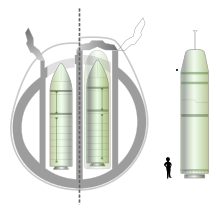Submarine-launched ballistic missile

A submarine-launched ballistic missile (SLBM) is a ballistic missile capable of being launched from some submarines. Modern variants usually deliver multiple independently targetable reentry vehicles (MIRVs) each of which carries a nuclear warhead and allows a single launched missile to strike several targets. Submarine-launched ballistic missiles operate in a different way from submarine-launched cruise missiles.
Modern submarine-launched ballistic missiles are closely related to intercontinental ballistic missiles, and in many cases SLBMs and ICBMs may be part of the same family of weapons.
History
The first conceptual design of a submarine-based launcher was developed by Nazi Germany in 1945, near the end of World War II. This concept included a launch tube, containing a ballistic missile, and towed behind the submarine. The war ended before it could be tested, but the engineers who had worked on it went on to work for the United States and the U.S.S.R. in their SLBM programs. These and other early SLBM systems required the submarines to be surfaced when they fired missiles, but their launching systems eventually were adapted to allow underwater launching in the 1950s and 1960s. The United States made the first successful underwater test launch of a Polaris missile on July 20, 1960.[1]
Forty days later, the U.S.S.R. made its first successful underwater launch of a submarine ballistic missile in the White Sea on September 10, 1960, from the same converted Project 611 (Zulu Class) submarine that had launched a R-11FM (SS-N-1 Scud-A from the surface. This was naval modification of SS-1 Scud) on September 16, 1955.[2][3] However, the Soviet Union was able to beat the U.S. in launching the first test flight of an armed SLBM, an R-13 that detonated in the Novaya Zemlya Test Range in the Arctic Ocean on October 20, 1961.[4]

Ballistic missile submarines were of great strategic importance for the U.S.A., the U.S.S.R., the U.K., and the French Republic during the Cold War. These submarines can hide from surface ships, ASW patol planes, and reconnaissance satellites for long periods of time. Then they could hypothetically fire their nuclear missiles with virtual impunity. This makes them immune to a first strike directed against nuclear forces, allowing each side to maintain the capability to launch a devastating retaliatory strike, even if all of the land-based ICBMs had been destroyed, hypothetically. This relieves each side of adopting a launch on warning posture, with its grave attendant risk of accidental nuclear war.
In addition, the deployment of highly accurate missiles on ultraquiet submarines allows an attacker to sneak up close to the enemy coast and launch a missile on a depressed trajectory (a suboptimal ballistic trajectory which trades off reduced throw-weight for a faster and lower path, effectively reducing the time between launch and impact), thus opening the possibility of a decapitation strike.[citation needed]
Types of SLBMs

Specific types of SLBMs (current, past and under development) include:
 United States of America (also known as Fleet Ballistic Missiles)
United States of America (also known as Fleet Ballistic Missiles)
- UGM-27 Polaris – Decommissioned
- UGM-73 Poseidon – Decommissioned
- UGM-96 Trident I (C4) – Decommissioned
- UGM-133 Trident II (D5) – Operational
- R-13 NATO name SS-N-4 – Decommissioned
- R-21 NATO name SS-N-5 – Decommissioned
- RSM-25[5] R-27 NATO name SS-N-6 – Decommissioned
- RSM-40[5] R-29 "Vysota", NATO name SS-N-8 "Sawfly" – Decommissioned
- R-27K, NATO name SS-NX-13 – designed for anti-ship use, never operational[6]
- RSM-45 R-31 NATO name SS-N-17 "Snipe"[5] – Decommissioned
- RSM-50[5] R-29R "Vysota", NATO name SS-N-18 "Stingray" – Operational
- RSM-52[5] R-39 "Rif", NATO name SS-N-20 "Sturgeon" – Decommissioned
- RSM-54 R-29RM "Shtil", NATO name SS-N-23 "Skiff" – Decommissioned (last ship is now under rebuild to R-29RMU "Sineva")[7]
- RSM-54 R-29RMU "Sineva", NATO name SS-N-23 "Skiff" – Operational
- RSM-54 R-29RMU2 "Layner" – Operational
- RSM-56 R-30 "Bulava", SS-NX-32[8] – Operational
- UGM-27 Polaris and Chevaline – Decommissioned
- UGM-133 Trident II (D5) – Operational
- M1 – Decommissioned
- M2 – Decommissioned
- M20 – Decommissioned
- M4 – Decommissioned
- M45 – Operational
- M51 – Operational
- K-15 Sagarika[10] – Developed and tested. Awaiting Arihant class submarines
- K-4[11] – Under development
- K-5 – Under development
Non-military use
Some former Russian SLBMs have been converted into Volna and Shtil' launch vehicles to launch satellites – either from a submarine or from a launch site on land.
See also
References
- ^ "Missiles 1963", Flight International: 752, 7 November 1963
- ^ Wade, Mark. "R-11". Encyclopedia Astronautica. Retrieved 23 April 2011.
- ^ Dygalo, V.A. "Start razreshaju (in Russian)". Nauka i Zhizn'. Retrieved 23 April 2011.
- ^ Polmar, Norman (2010). Project Azorian: The CIA and the Raising of the K-129. Naval Institute Press. p. 21. ISBN 978-1-59114-690-2.
{{cite book}}: More than one of|author1=and|last=specified (help) - ^ a b c d e Korabli VMF SSSR, Vol. 1, Part 1, Yu. Apalkov, Sankt Peterburg, 2003, ISBN 5-8172-0069-4
- ^ SS-NX-13 SLBM System (U), Defense Intelligence Agency, D5T-1020S-4l7-75, 1 October 1975
- ^ "SSBN K-51 Verkhoturye arrived to Zvezdochka for repairs today". Rusnavy.com. 23 August 2010. Retrieved 8 October 2010.
- ^ NASIC-1031-0985-09
- ^ "JL-1 [CSS-N-3] – China Nuclear Forces". Fas.org. Retrieved 10 February 2012.
- ^ http://www.drdo.gov.in/drdo/English/dpi/Frontline02Jan09.pdf
- ^ 'INS Arihant' to sail on deterrent patrol after commissioning[dead link]
External links
- Video showing the launch of a Trident SLBM.
- Estimated Strategic Nuclear Weapons Inventories (September 2004)
- R-11 SLBM
- Trident Submarines Are Killing Machines Unparalleled In Human History.[dead link]
